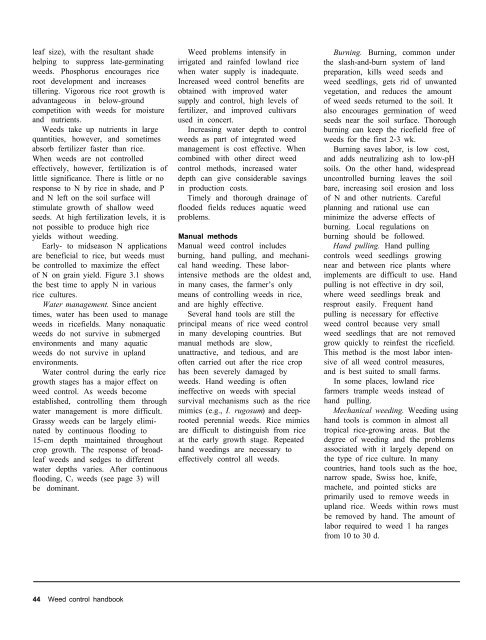A handbbok on Weed Control in Rice.pdf
A handbbok on Weed Control in Rice.pdf
A handbbok on Weed Control in Rice.pdf
Create successful ePaper yourself
Turn your PDF publications into a flip-book with our unique Google optimized e-Paper software.
leaf size), with the resultant shade<br />
help<strong>in</strong>g to suppress late-germ<strong>in</strong>at<strong>in</strong>g<br />
weeds. Phosphorus encourages rice<br />
root development and <strong>in</strong>creases<br />
tiller<strong>in</strong>g. Vigorous rice root growth is<br />
advantageous <strong>in</strong> below-ground<br />
competiti<strong>on</strong> with weeds for moisture<br />
and nutrients.<br />
<strong>Weed</strong>s take up nutrients <strong>in</strong> large<br />
quantities, however, and sometimes<br />
absorb fertilizer faster than rice.<br />
When weeds are not c<strong>on</strong>trolled<br />
effectively, however, fertilizati<strong>on</strong> is of<br />
little significance. There is little or no<br />
resp<strong>on</strong>se to N by rice <strong>in</strong> shade, and P<br />
and N left <strong>on</strong> the soil surface will<br />
stimulate growth of shallow weed<br />
seeds. At high fertilizati<strong>on</strong> levels, it is<br />
not possible to produce high rice<br />
yields without weed<strong>in</strong>g.<br />
Early- to midseas<strong>on</strong> N applicati<strong>on</strong>s<br />
are beneficial to rice, but weeds must<br />
be c<strong>on</strong>trolled to maximize the effect<br />
of N <strong>on</strong> gra<strong>in</strong> yield. Figure 3.1 shows<br />
the best time to apply N <strong>in</strong> various<br />
rice cultures.<br />
Water management. S<strong>in</strong>ce ancient<br />
times, water has been used to manage<br />
weeds <strong>in</strong> ricefields. Many n<strong>on</strong>aquatic<br />
weeds do not survive <strong>in</strong> submerged<br />
envir<strong>on</strong>ments and many aquatic<br />
weeds do not survive <strong>in</strong> upland<br />
envir<strong>on</strong>ments.<br />
Water c<strong>on</strong>trol dur<strong>in</strong>g the early rice<br />
growth stages has a major effect <strong>on</strong><br />
weed c<strong>on</strong>trol. As weeds become<br />
established, c<strong>on</strong>troll<strong>in</strong>g them through<br />
water management is more difficult.<br />
Grassy weeds can be largely elimi-<br />
nated by c<strong>on</strong>t<strong>in</strong>uous flood<strong>in</strong>g to<br />
15-cm depth ma<strong>in</strong>ta<strong>in</strong>ed throughout<br />
crop growth. The resp<strong>on</strong>se of broad-<br />
leaf weeds and sedges to different<br />
water depths varies. After c<strong>on</strong>t<strong>in</strong>uous<br />
flood<strong>in</strong>g, C3 weeds (see page 3) will<br />
be dom<strong>in</strong>ant.<br />
44 <strong>Weed</strong> c<strong>on</strong>trol handbook<br />
<strong>Weed</strong> problems <strong>in</strong>tensify <strong>in</strong><br />
irrigated and ra<strong>in</strong>fed lowland rice<br />
when water supply is <strong>in</strong>adequate.<br />
Increased weed c<strong>on</strong>trol benefits are<br />
obta<strong>in</strong>ed with improved water<br />
supply and c<strong>on</strong>trol, high levels of<br />
fertilizer, and improved cultivars<br />
used <strong>in</strong> c<strong>on</strong>cert.<br />
Increas<strong>in</strong>g water depth to c<strong>on</strong>trol<br />
weeds as part of <strong>in</strong>tegrated weed<br />
management is cost effective. When<br />
comb<strong>in</strong>ed with other direct weed<br />
c<strong>on</strong>trol methods, <strong>in</strong>creased water<br />
depth can give c<strong>on</strong>siderable sav<strong>in</strong>gs<br />
<strong>in</strong> producti<strong>on</strong> costs.<br />
Timely and thorough dra<strong>in</strong>age of<br />
flooded fields reduces aquatic weed<br />
problems.<br />
Manual methods<br />
Manual weed c<strong>on</strong>trol <strong>in</strong>cludes<br />
burn<strong>in</strong>g, hand pull<strong>in</strong>g, and mechani-<br />
cal hand weed<strong>in</strong>g. These labor-<br />
<strong>in</strong>tensive methods are the oldest and,<br />
<strong>in</strong> many cases, the farmer’s <strong>on</strong>ly<br />
means of c<strong>on</strong>troll<strong>in</strong>g weeds <strong>in</strong> rice,<br />
and are highly effective.<br />
Several hand tools are still the<br />
pr<strong>in</strong>cipal means of rice weed c<strong>on</strong>trol<br />
<strong>in</strong> many develop<strong>in</strong>g countries. But<br />
manual methods are slow,<br />
unattractive, and tedious, and are<br />
often carried out after the rice crop<br />
has been severely damaged by<br />
weeds. Hand weed<strong>in</strong>g is often<br />
<strong>in</strong>effective <strong>on</strong> weeds with special<br />
survival mechanisms such as the rice<br />
mimics (e.g., I. rugosum ) and deep-<br />
rooted perennial weeds. <strong>Rice</strong> mimics<br />
are difficult to dist<strong>in</strong>guish from rice<br />
at the early growth stage. Repeated<br />
hand weed<strong>in</strong>gs are necessary to<br />
effectively c<strong>on</strong>trol all weeds.<br />
Burn<strong>in</strong>g. Burn<strong>in</strong>g, comm<strong>on</strong> under<br />
the slash-and-burn system of land<br />
preparati<strong>on</strong>, kills weed seeds and<br />
weed seedl<strong>in</strong>gs, gets rid of unwanted<br />
vegetati<strong>on</strong>, and reduces the amount<br />
of weed seeds returned to the soil. It<br />
also encourages germ<strong>in</strong>ati<strong>on</strong> of weed<br />
seeds near the soil surface. Thorough<br />
burn<strong>in</strong>g can keep the ricefield free of<br />
weeds for the first 2-3 wk.<br />
Burn<strong>in</strong>g saves labor, is low cost,<br />
and adds neutraliz<strong>in</strong>g ash to low-pH<br />
soils. On the other hand, widespread<br />
unc<strong>on</strong>trolled burn<strong>in</strong>g leaves the soil<br />
bare, <strong>in</strong>creas<strong>in</strong>g soil erosi<strong>on</strong> and loss<br />
of N and other nutrients. Careful<br />
plann<strong>in</strong>g and rati<strong>on</strong>al use can<br />
m<strong>in</strong>imize the adverse effects of<br />
burn<strong>in</strong>g. Local regulati<strong>on</strong>s <strong>on</strong><br />
burn<strong>in</strong>g should be followed.<br />
Hand pull<strong>in</strong>g. Hand pull<strong>in</strong>g<br />
c<strong>on</strong>trols weed seedl<strong>in</strong>gs grow<strong>in</strong>g<br />
near and between rice plants where<br />
implements are difficult to use. Hand<br />
pull<strong>in</strong>g is not effective <strong>in</strong> dry soil,<br />
where weed seedl<strong>in</strong>gs break and<br />
resprout easily. Frequent hand<br />
pull<strong>in</strong>g is necessary for effective<br />
weed c<strong>on</strong>trol because very small<br />
weed seedl<strong>in</strong>gs that are not removed<br />
grow quickly to re<strong>in</strong>fest the ricefield.<br />
This method is the most labor <strong>in</strong>tensive<br />
of all weed c<strong>on</strong>trol measures,<br />
and is best suited to small farms.<br />
In some places, lowland rice<br />
farmers trample weeds <strong>in</strong>stead of<br />
hand pull<strong>in</strong>g.<br />
Mechanical weed<strong>in</strong>g. <strong>Weed</strong><strong>in</strong>g us<strong>in</strong>g<br />
hand tools is comm<strong>on</strong> <strong>in</strong> almost all<br />
tropical rice-grow<strong>in</strong>g areas. But the<br />
degree of weed<strong>in</strong>g and the problems<br />
associated with it largely depend <strong>on</strong><br />
the type of rice culture. In many<br />
countries, hand tools such as the hoe,<br />
narrow spade, Swiss hoe, knife,<br />
machete, and po<strong>in</strong>ted sticks are<br />
primarily used to remove weeds <strong>in</strong><br />
upland rice. <strong>Weed</strong>s with<strong>in</strong> rows must<br />
be removed by hand. The amount of<br />
labor required to weed 1 ha ranges<br />
from 10 to 30 d.











